- Joined
- Dec 28, 2009
- Messages
- 288
- Points
- 63
Burning Lasers Instant Nonreversible Damaged Eyes
Get Some Safety Goggles Now!
___________________________________________________________________
20050501 Rochester, MN
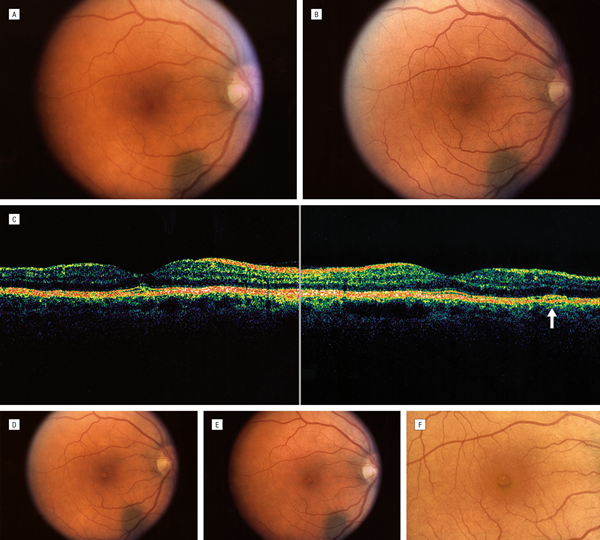
Objective - To report retinopathy following exposure to light from a commercially available class 3A green laser pointer
_____________________________________________
20100609 Liverpool – Manchester UK
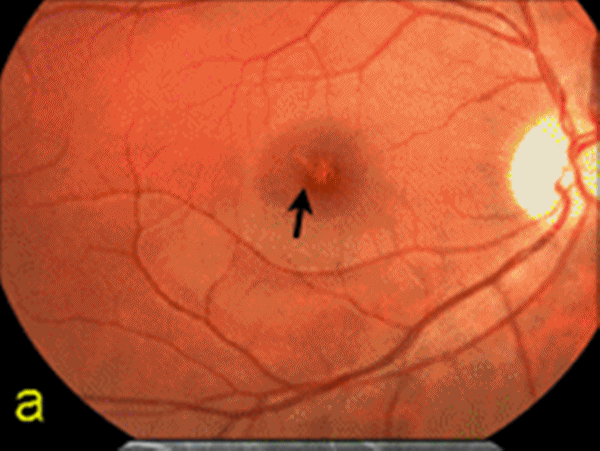
Laser pointers 'pose danger to eyes'
_____________________________________________
20100909 Switzerland
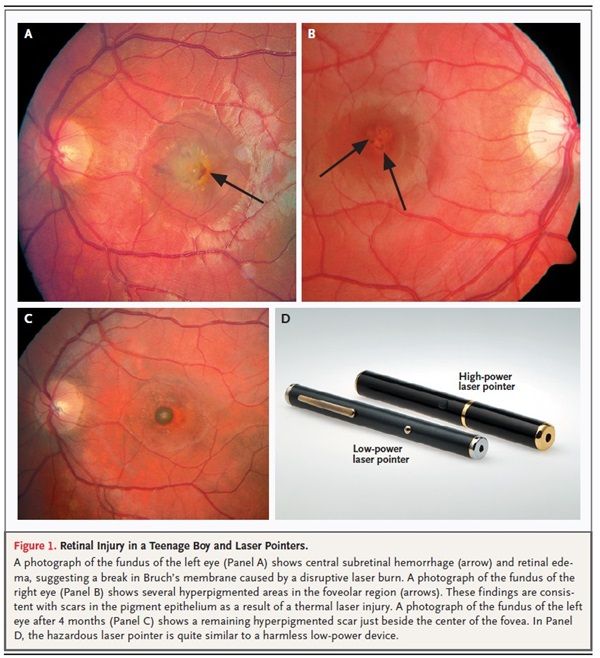
Retinal Injury in a Teenage Boy from a Laser Pointer
_____________________________________________
20110228 Valhalla, N.Y.

Lasers Rise as Threat to Retinas
_____________________________________________
20120907 Heidelberg Germany
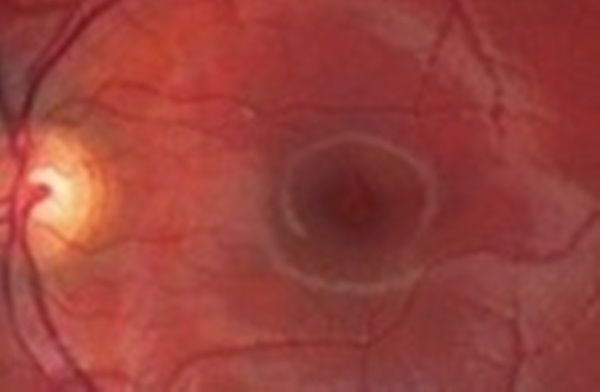
11-year-old suffers eye injury from classmates playing
_____________________________________________
20130301 Prince George’s County MD
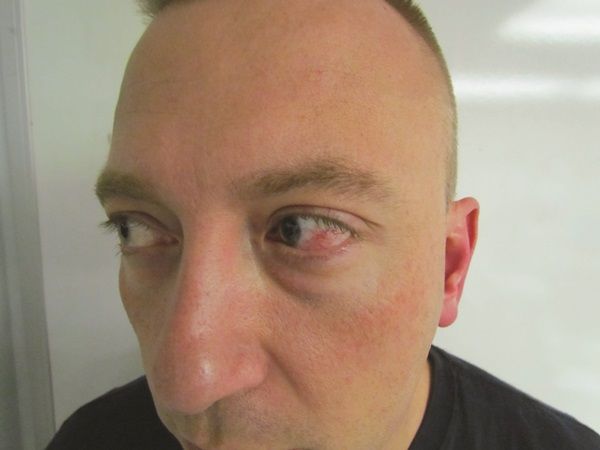
Helicopter Crewmember Injured By Laser
_____________________________________________
20131212 UK
‘Toy’ Laser Macular Burns in Children
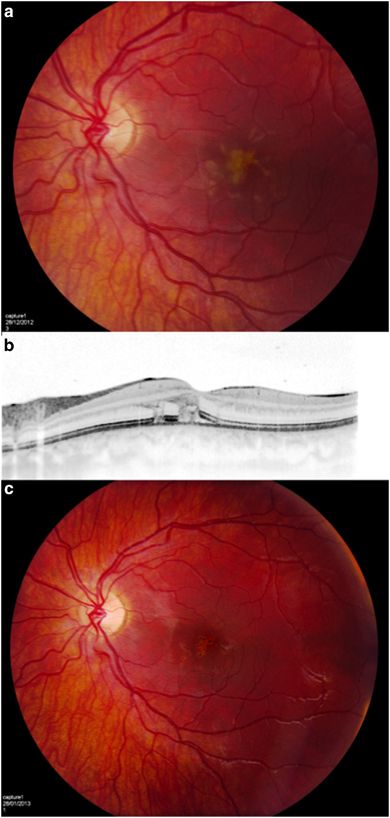
_____________________________________________
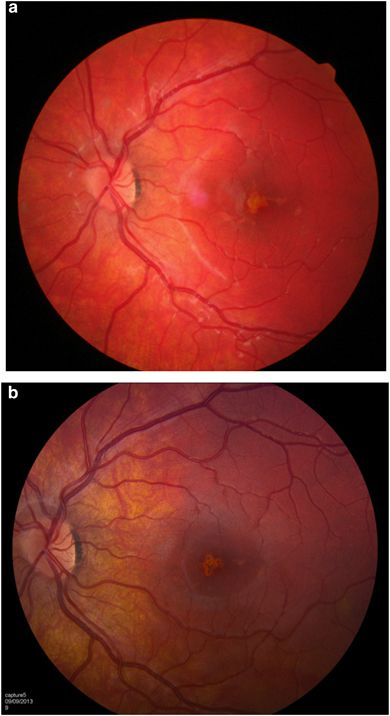
___________________________________________________________________
___________________________________________________________________
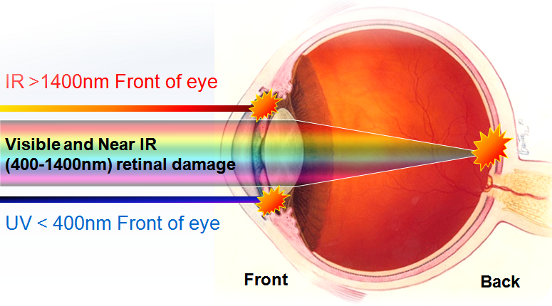
Princeton.edu - Eye Absorption Site vs. Wavelength

Encyclopedia of Laser Physics and Technology - Laser Safety
Princeton University - SECTION 2: LASER HAZARDS
___________________________________________________________________
Although the following link is written toward laser illumination eyesight hazard affects for pilots, this has some very interesting and highly organized data, albeit it is a lot of info and not a quick read.
Laser Pointer Safety - Different lasers' hazards compared
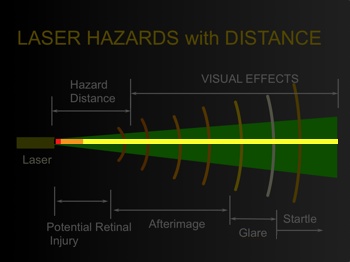
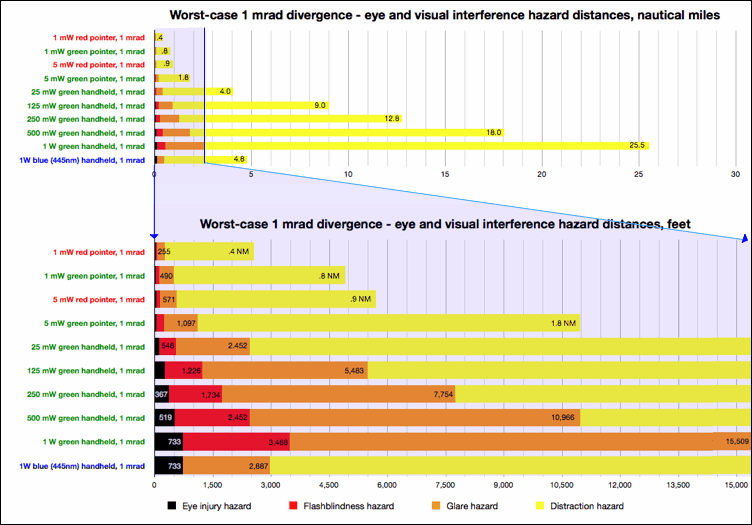
Please note where at the distance 445nm will cause flash blindness, it is moreover within the eye injury hazard level.
___________________________________________________________________
The following links provide a selection of straight forward apps and some simple calculations for determining degrees of laser illumination hazard.
Easy HAZ Basic Web Version
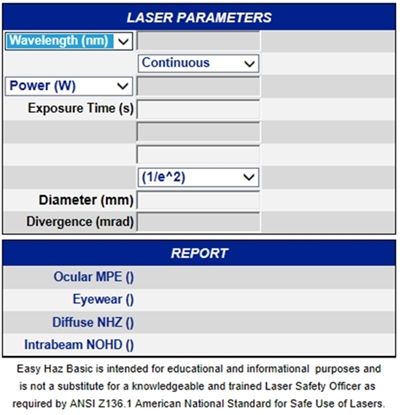
Laser Institute of America's (LIA) Free OD Calculator
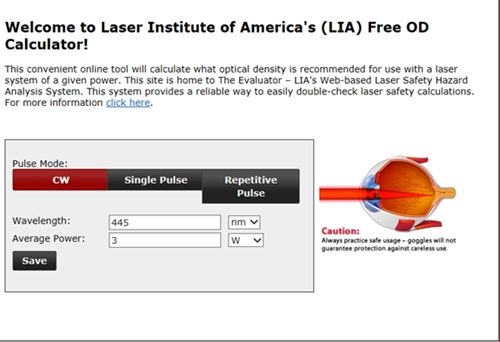
Laser Pointer Safety - Laser safety calculations
Within the link below reference was made to this previous LPF discussion ^^Blindness Post#46 concerning the apparent and seemingly counter intuitive lack of flash blindness effect by 445nm blue lasers.
Laser Pointer Safety - Different lasers' hazards compared
steve001 posted this link to laservisuals.com here:Re: How far is far enough for the human eye?
Laser Visuals - Scanguard laser show analysis software : Lite Version
iPhone Laser Hazard Calculation Apps listed in the links below that ElektroFreak posted about here: Laser Hazard Distance iPhone App
iTunes Download Link - Laser Hazard Distance - id460996018 - Free
Laser Show Safety
iTunes Download Link - Laser Show Safety - id452579944 - $6.99
MPE and NHZ Calculation Guide - The University of Chicago
Other Laser Hazard Analysis Links:
Nominal Ocular Hazard Distance and Area
Laser Hazard Analysis for LUMETRICSTM OptiGauge Measurement Probe Super LED
Download LaserSafe PC Demo Version
Eye-Safety Analysis Of Current Laser-Based Scanned-Beam Projection Systems
Laser Safety Training - Florida Institute of Technology
___________________________________________________________________
US Government Regulations
avstop.com - President Obama Signs The FAA Modernization And Reform Act Of 2012 (H.R. 658)
LaserPointerSafety.com -U.S.: Illegal to aim laser pointers at aircraft or their flight path
It is subject to interpretation within the law above for civil/criminal penalties for shining a laser into an "aircraft's flight path" for enforcement by the FAA below:
AirlinePilots.Wordpress.com - FAA Steps Up Enforcement of Laser Penalties
Chapter 29. Outdoor Laser Operations
1. Laser Free Zone (LFZ). Airspace in the immediate proximity of the airport, up to and including 2,000 feet AGL, extending 2 NM in all directions measured from the runway centerline. Additionally, the LFZ includes a 3 NM extension, 2,500 feet each side of the extended runway centerline, of each usable runway surface, up to 2,000' AGL of each useable runway surface. The effective irradiance of a visible laser beam is restricted to a level that should not cause any visual distraction or disruption.
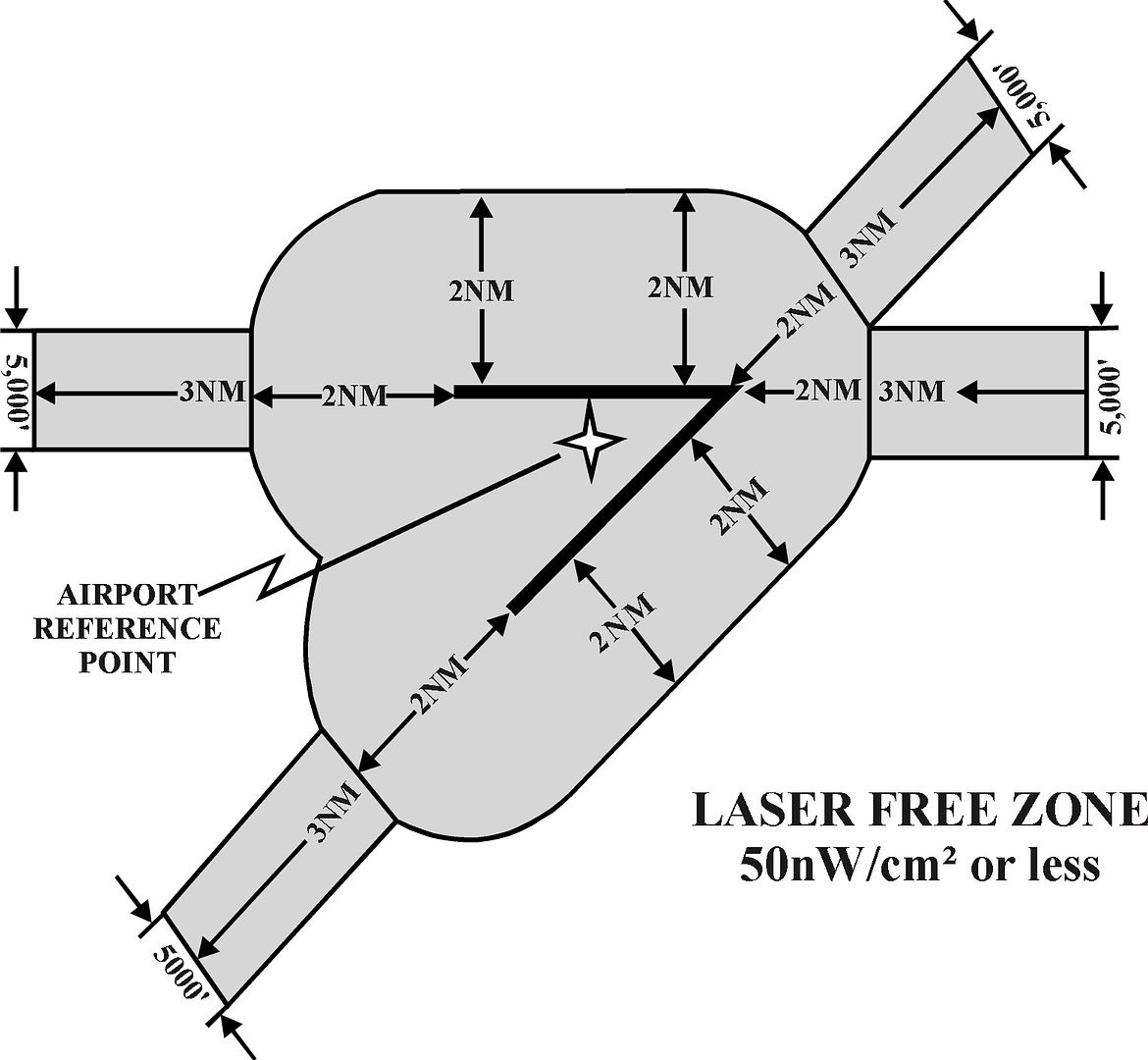
2. Critical Flight Zone (CFZ). Airspace within a 10 NM radius of the airport reference point, up to and including 10,000 feet AGL. The effective irradiance of a visible laser beam is restricted to a level that should not cause transient visual effects (e.g., glare, flashblindness, or afterimage).
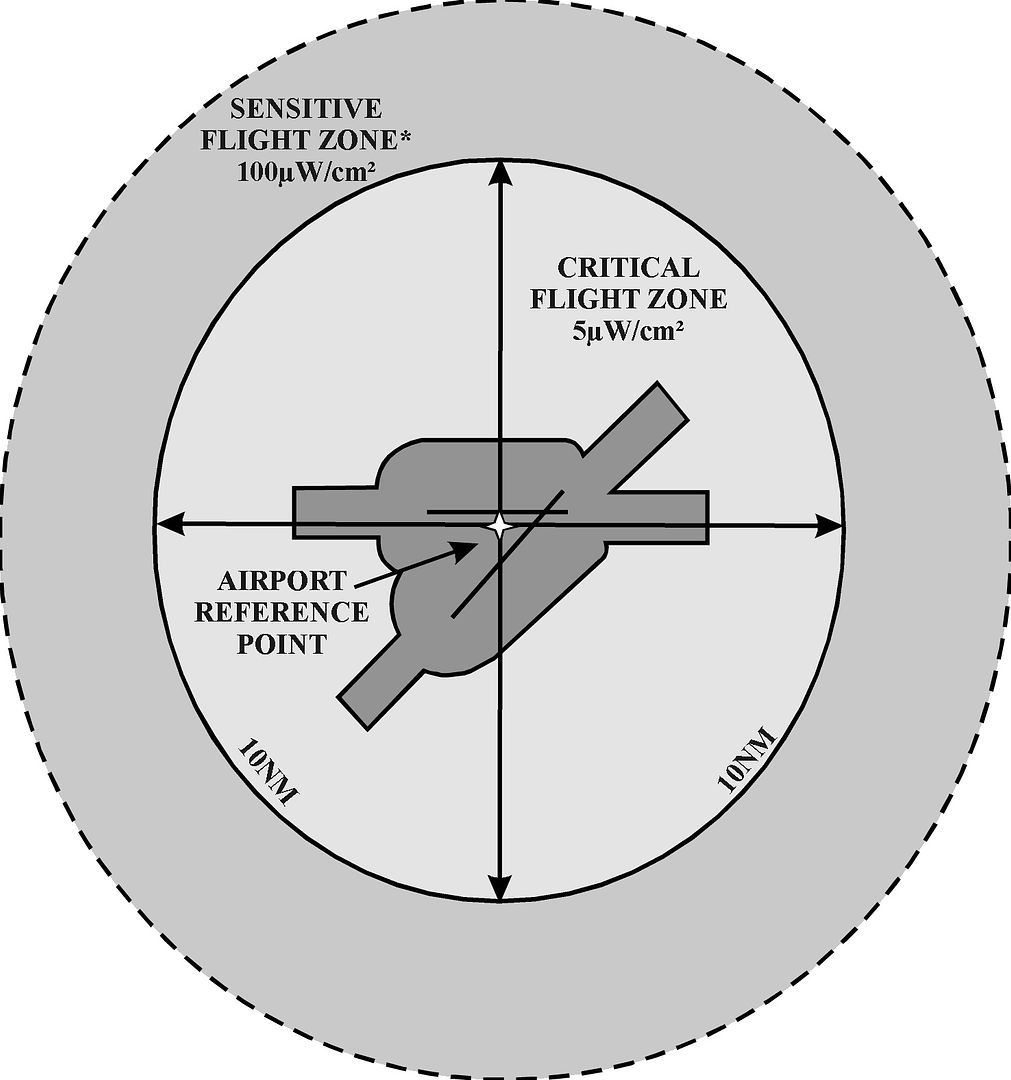
3. Sensitive Flight Zone (SFZ). Airspace outside the critical flight zones that authorities (e.g., FAA, local departments of aviation, military) identify to be protected from the potential visual effects of laser beams.
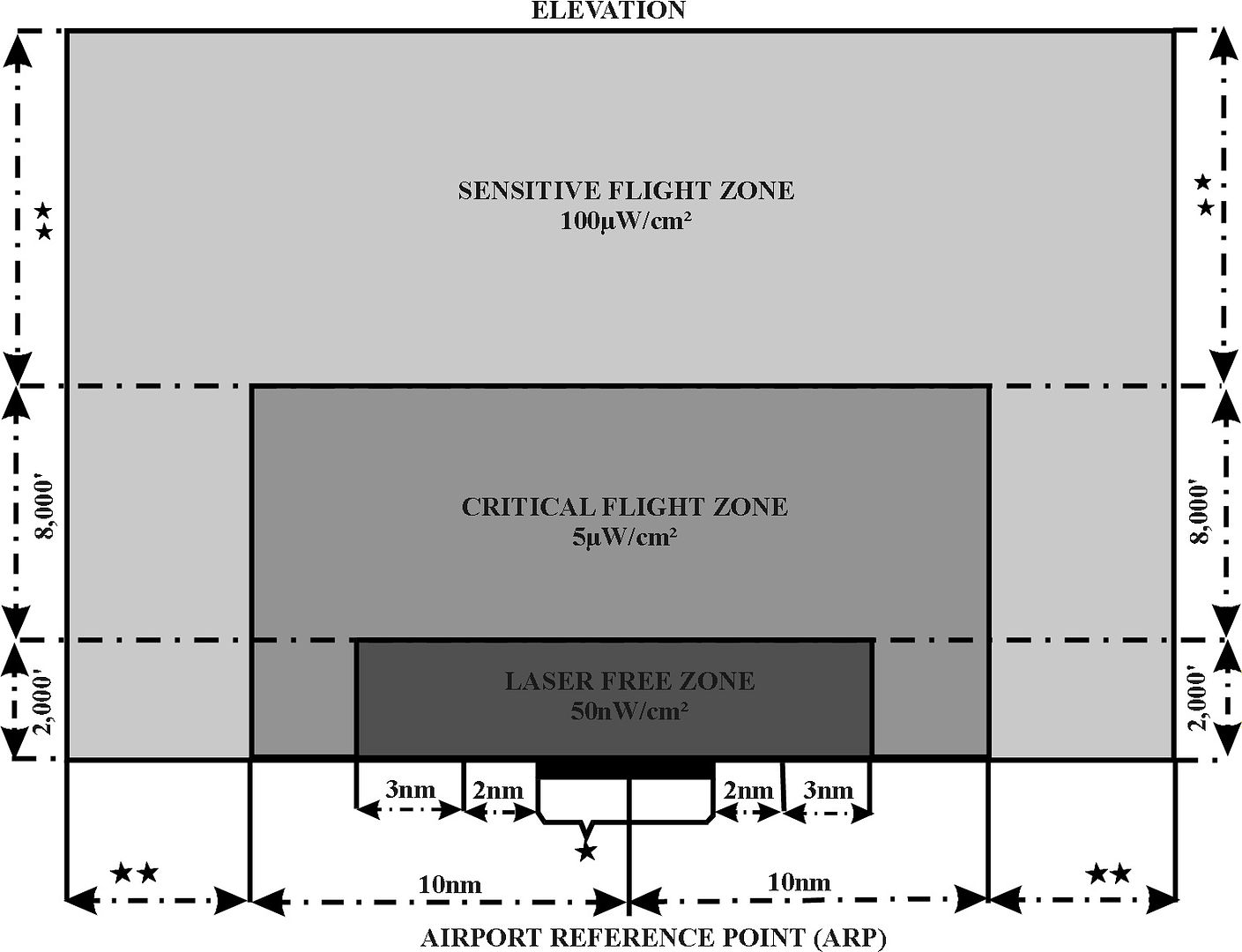
4. Normal Flight Zones (NFZ). Airspace not defined by the Laser Free, Critical, or Sensitive Flight Zones. As with all the above zones, the NFZ must be protected from a visible or invisible laser beam that exceeds the MPE.
LaserPointerSafety.com - US: Latest FAA Laser/Aircraft Incident Statistics
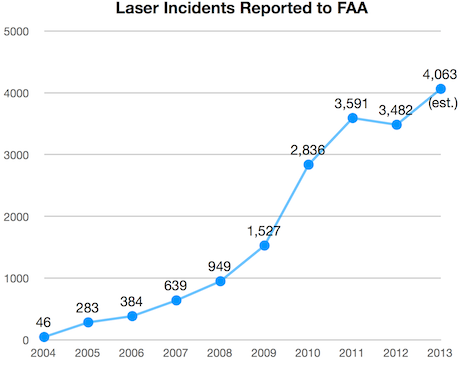
Also please know that any laser beam visible by a pilot during flight can and will be reported as a “laser incident”, regardless of whether it is an actual hazard or not, nor whether it is logical or reasonable for the FAA to track it as a valid aircraft “laser incident”
****Please PM me if you find dead links on this page****
Too Stupid to Own a Laser
Idiot with a Laser
Moron with a Laser
Shined Laser into Eye
Pointed Laser into Eye
Struck in Eye by Laser
Blinded by Laser
Laser Eye Injury
Laser Damaged Vision
Get Some Safety Goggles Now!
___________________________________________________________________
20050501 Rochester, MN

Objective - To report retinopathy following exposure to light from a commercially available class 3A green laser pointer
The beam power of our green laser was variable and between 3 and 7 mW, although the manufacturer stated that the light output was less than 5 mW. The maximum permissible exposure is 0.39 mW for exposures between 1 and 15 minutes, assuming a 7-mm limiting aperture (pupil diameter).4 Retinal exposure from our laser exceeded this limit by 8 to 18 times.
Methods A 55-year-old woman with a ring melanoma was scheduled for enucleation. The eye (visual acuity 20/20) had a healthy-appearing macular retina. The retina was exposed to light from a commercially available class 3A green laser: 60 seconds to the fovea, 5 minutes to a site 5° below the fovea, and 15 minutes to a site 5° superior to the fovea. Color photographs were obtained before and after exposure. The eye was enucleated 20 days after exposure.
Results Laser power measurements averaged less than 5 mW. Retinopathy was observed 24 hours after laser exposure. This was characterized by a yellowish discoloration at the level of the retinal pigment epithelium (RPE) in the subfoveal region and at the site superior to the macula where the retina received 15 minutes of laser exposure. Each site developed granular changes at the level of the RPE within 5 days of exposure. Histologic study showed RPE damage in the exposed subfoveal and parafoveal regions.
In this experiment, we documented the development of retinopathy in a human eye after purposeful exposure to light from a green laser pointer. In previous studies with red laser pointers, we failed to produce any evidence of retinopathy despite exposures of the retina to continuous light for up to 15 minutes.1 The fact that we were able to demonstrate green laser pointer–induced retinopathy with exposure times as short as 60 seconds may not be surprising, since the human retina is much more sensitive to shorter than longer wavelengths. Also, melanin in the pigment epithelium absorbs more energy at shorter wavelengths than longer wavelengths. The appearance of the lesion after 60 seconds of green laser exposure was similar to the clinical appearance of solar retinopathy in patients who have stared at a solar eclipse.
_____________________________________________
20100609 Liverpool – Manchester UK

Laser pointers 'pose danger to eyes'
The teenager in question had bought a green, diode laser pointer over the internet and, while playing with it, shone the laser beam into his eyes. Two months later, his vision had improved but some retinal damage remained. "Although his vision has now returned to normal, he is at risk of developing problems later on in life as a result of the damage to his retina,"
_____________________________________________
20100909 Switzerland

Retinal Injury in a Teenage Boy from a Laser Pointer
A 15-year-old boy had ordered a handheld laser pointer with green light on the Internet to use as a toy for popping balloons from a distance and burning holes into paper cards and his sister’s sneakers. The boy’s life changed when he was playing with his laser pointer in front of a mirror to create a “laser show,” during which the laser beam hit his eyes several times. He noticed immediate blurred vision in both of his eyes. Hoping that the visual loss would be transient and afraid of telling his parents, he waited 2 weeks before seeking an ophthalmic assessment, when he could no longer disguise his bad vision. His visual acuity was so poor in his left eye that he was only able to count fingers at a distance of 3 ft, and it was 20/50 in his right eye. A funduscopic examination revealed a dense subretinal hemorrhage in his left macula (Fig. 1A) and several tiny round scars in the pigment epithelium of the foveolar region of his right eye (Fig. 1B). The clinical findings were consistent with severe bilateral retinal laser injury.1 After 4 months, the boy’s visual function remained impaired but improved to 20/32 in the right eye spontaneously and to 20/25 with a remaining scar just beside the center of the fovea in the left eye after one intravitreal injection of ranibizumab (Fig. 1C). In the past, laser pointers sold to the public had a maximal output of 5 mW, which is regarded as harmless because the human eye protects itself with blink reflexes.2 The measured output of the laser in this case was 150 mW.
_____________________________________________
20110228 Valhalla, N.Y.

Lasers Rise as Threat to Retinas
Not long ago a high school student went to see Dr. Robert G. Josephberg, a retina specialist at Westchester Medical Center in Valhalla, N.Y., complaining of a blind spot in his left eye. The boy, who did not want to be identified, said the injury occurred when a friend waved a green laser pointer in front of his face.(Whether it will heal completely is uncertain.)
Dr. Josephberg said that at first he doubted the story. “I didn’t believe that a green laser was out there that could cause the damage,” he said.
But it turned out the laser put out 50 milliwatts of power, 10 times the F.D.A. limit. And as he investigated his patient’s case, Dr. Josephberg went online and bought a 100-milliwatt pointer for $28. He could hardly believe how easy it was.
_____________________________________________
20120907 Heidelberg Germany

11-year-old suffers eye injury from classmates playing
The children were on a Heidelberg school playground. The laser was aimed from a meter or so, first into one eye and then into the other.Afterwards, the boy could not see clearly and had a black spot in his visual field. He kept this from his parents for about three weeks, after which the boy was seen by Professor Stefan Dithmar and Dr. Stefanie Pollithy at the University of Heidelberg Department of Ophthalmology. Their diagnosis was “acute bilateral impaired vision and central scotoma
•The schoolyard exposure lasted several seconds
•The laser pointer was measured at 55 milliwatts
•The boy had impaired vision and a black spot on both eyes
•Nine weeks after the exposure his vision got a bit better
_____________________________________________
20130301 Prince George’s County MD

Helicopter Crewmember Injured By Laser
A member of a police helicopter crew suffered an eye injury after a hand-held laser was shined in his face. The incident, which occurred on the evening of Jan. 8, 2013, left a Prince George’s County (Md.) police officer with scar tissue in his left eye.
The crew guided ground officers to the apartment of 40-year-old Jules G. Labonte of College Park, Md., who said he was demonstrating the laser to his nephew. Officers seized a Wicked Lasers-brand “Arctic” hand-held laser. (Its Class IV power is three times greater than pointers generally used in an office or classroom setting.) Thirty minutes later, Elrod experienced pain and redness in his left eye. An ophthalmologist later connected his symptoms to the laser beam, which had caused temporary scarring, even from that distance.
_____________________________________________
20131212 UK
‘Toy’ Laser Macular Burns in Children
Case 1

A nine-year-old boy, with a history of right amblyopia, presented on Boxing Day with a 24 h history of painless vision loss in his better eye. He had attended a community optometrist 3 days previously, when his vision was 6/5 in his left eye. At presentation, corrected Snellen vision was 6/12 in the right eye and 6/15 in the left. An acute vitelliform-like maculopathy was present in the left eye. Three days later, the vitelliform-like changes resolved to leave RPE changes at the left macula
The family mentioned that the child had been given a laser ‘toy’ pointer, purchased via the internet, and had been playing with this on Christmas Day. The child denied looking directly into the laser beam. Examination of the ‘toy’ laser pointers bought by the family revealed three separate laser devices made in China, blue (405 nm), green (532 nm), and red (650 nm) with outputs of 57 mW (blue laser), 42 mW (green laser) and 72 mW (red laser)
_____________________________________________
Case 2

An 11-year-old boy was referred by his community optometrist with recent onset bilateral decreased vision (best-corrected Snellen acuity of 6/7.5 both eyes at baseline) with bilateral ‘yellow’ macular lesions. Retinal photographs taken by the optometrist revealed a bilateral vitelliform-like maculopathy, which had resolved to leave sub-foveal RPE changes when he was seen in the paediatric ophthalmology clinic 8 weeks later. At this point his recorded acuities had deteriorated to 6/12 in the right eye and 6/15 in the left eye. This child admitted that a friend aimed a laser ‘toy’ into both his eyes prior to him developing decreased visual acuity. We were not able to examine the laser device responsible for injury in this case.
___________________________________________________________________
Published on Feb 26, 2013
The topic of this seminar presented by the Physics Department of Fort Hays State University is Laser Safety. The presenters are Dr. C.D. Clark and Dr. Jack Maseberg. Both gentlemen are Assistant Professors in the Department of Physics. Explained are different types of lasers, types of damage that can occur from laser exposure, and precautions to take when working with lasers.
___________________________________________________________________

Princeton.edu - Eye Absorption Site vs. Wavelength
The wavelength determines where the laser energy is absorbed in the eye.

Lasers in the visible and near infrared range of the spectrum have the greatest potential for retinal injury, as the cornea and the lens are transparent to those wavelengths and the lens can focus the laser energy onto the retina. The maximum absorption of laser energy onto the retina occurs in the range from 400 - 550 nm. Argon and YAG lasers operate in this range, making them the most hazardous lasers with respect to eye injuries. Wavelengths of less than 550 nm can cause a photochemical injury similar to sunburn. Photochemical effects are cumulative and result from long exposures (over 10 seconds) to diffuse or scattered light. Table 3 summarizes the most likely effects of overexposure to various commonly used lasers.
Encyclopedia of Laser Physics and Technology - Laser Safety
Laser beams can be hazardous, particularly for the eye (and sometimes also for the skin), mostly because they can have high optical intensities even after propagation over relatively long distances. Even when the intensity at the entrance of the eye is moderate, laser radiation can be focused by the eye's lens to a small spot on the retina, where it can cause serious permanent damage within fractions of a second – even when the power level is only of the order of a few milliwatts. Damage can result from both thermal and photochemical effects. Laser damage of the eye is not always immediately noticed: it is possible e.g. to burn peripheral regions of the retina, causing blind spots which may be noticed only years later.
Princeton University - SECTION 2: LASER HAZARDS
Beam-Related Hazards
Non-Beam Hazards
The hazards of lasers may be separated into two general categories – beam-related hazards to eyes and skin and non-beam hazards, such as electrical and chemical hazards.
___________________________________________________________________
Although the following link is written toward laser illumination eyesight hazard affects for pilots, this has some very interesting and highly organized data, albeit it is a lot of info and not a quick read.
Laser Pointer Safety - Different lasers' hazards compared
The NOHD is a standard laser safety concept. It expresses the “nominal” and not the actual distance at which a laser is deemed eye-safe. Keep in mind that the NOHD includes a safety factor of approximately 2/3. Example: for a 1 watt 1 milliradian visible laser with an NOHD of 733 feet, this means that under ideal conditions the laser has a 50% chance of causing a minimally detectable retinal lesion in the eye at 1/3 the NOHD distance, or 244 feet. The remaining 2/3 of the distance (489 feet) gives an additional safety factor. Obviously, the longer the distance from the laser, the lower the chance of eye injury. At 733 feet, there is essentially no chance of causing a retinal lesion in the eye.

The black eye injury hazard distance, and the red flash blindness distance, are barely visible. Only the orange glare, and yellow distraction distances show up well. (The actual distance numbers do not matter. We are concerned with the proportional distances for the four hazards, which for visible lasers of any given color are always the same.)

Please note where at the distance 445nm will cause flash blindness, it is moreover within the eye injury hazard level.
___________________________________________________________________
The following links provide a selection of straight forward apps and some simple calculations for determining degrees of laser illumination hazard.
Easy HAZ Basic Web Version
We think basic, reliable, user-friendly laser hazard analysis calculation software should be available for all laser users as a service to the laser community. It's one more thing that gets taken care of better if laser users do it themselves. So we have. EASY HAZTM BASIC does the most essential laser hazard analysis calculations and is designed to give users with minimal hazard calculation experience the most useful information in the simplest format. The emphasis is on easy. EASY HAZTM BASIC calculates MPE, Optical Density, Intrabeam NOHD, and worst case Diffuse Reflection NHZ for CW, Single Pulse, and Repetitive Pulse lasers.

Laser Institute of America's (LIA) Free OD Calculator
This convenient online tool will calculate what optical density is recommended for use with a laser system of a given power. This site is home to The Evaluator – LIA's Web-based Laser Safety Hazard Analysis System. This system provides a reliable way to easily double-check laser safety calculations. For more information click here

Laser Pointer Safety - Laser safety calculations
This page presents laser safety equations and example calculations. These are valid for the type of lasers commonly misused by the general public: laser pointers and commercially available handheld lasers. Specifically, this means lasers emitting visible light (400-700 nanometers) that is continuous (e.g., not pulsed lasers).
Within the link below reference was made to this previous LPF discussion ^^Blindness Post#46 concerning the apparent and seemingly counter intuitive lack of flash blindness effect by 445nm blue lasers.
Laser Pointer Safety - Different lasers' hazards compared
Note for careful readers (such as those at LaserPointerForums.com): Some observant people have noticed that there is no flashblindness distance indicated for the 1W blue handheld (e.g., no red part on the bottom bar). This is because the flashblindness distance of this laser is only 646 feet. That’s shorter than the 733 feet which is the eye injury hazard distance. Here’s how to think of this. The laser’s blue color appears relatively dim to the human eye. Beyond 646 feet it doesn’t appear bright enough to cause flashblindness, yet it is still within the eye injury hazard distance of 733 feet.
steve001 posted this link to laservisuals.com here:Re: How far is far enough for the human eye?
Laser Visuals - Scanguard laser show analysis software : Lite Version
Scanguard Lite has been designed to introduce the user to key laser safety concepts and the help aid in basic laser safety assessments. The best thing is that it is available free of charge as a request from this website, meaning that even if you are not quite sure if laser safety is something that you need to be concerned with, you can access a useful software tool without having to spend any real money.
iPhone Laser Hazard Calculation Apps listed in the links below that ElektroFreak posted about here: Laser Hazard Distance iPhone App
iTunes Download Link - Laser Hazard Distance - id460996018 - Free
Laser Hazard Distance is an easy to use laser safety calculator that can be used to help determine the safe viewing distance for direct exposure to visible laser beams. The light created by a laser beam is far more concentrated than other forms of light, and if viewed directly can be harmful to eyesight. The energy in a laser beam however becomes less harmful the further along the beam the light travels, eventually reaching a point where the laser risk is low. Laser Hazard Distance can be used to help determine this distance which is known as the Nominal Ocular Hazard Distance or NOHD.
Laser Show Safety
iTunes Download Link - Laser Show Safety - id452579944 - $6.99
Laser Show Safety allows the exposure safety of a wide range of laser show effects to be checked against safe exposure limits, helping to reduce the chance of harm occurring as a result of excessive exposure to beams too strong to enter the eye.
MPE and NHZ Calculation Guide - The University of Chicago
MPE and NHZ Calculation Guide
The Maximum Permissible Exposure (MPE)
The single most useful number in laser safety calculations is the Maximum Permissible Exposure (MPE). This is the minimum irradiance or radiant exposure that may be incident upon the eye (or the skin) without causing biological damage.
The Nominal Hazard Zone (NHZ)
The other major definition for laser safety calculations is the Nominal Hazard Zone (NHZ). This is a distance within which the irradiance of a beam is greater than the MPE. Besides being specific to a given wavelength and time of exposure, a different NHZ can be defined for the beam’s path to your eye – direct viewing, specular reflectance, or diffuse reflectance.
The NHZ is a practical definition; it has a specific shape around your particular laboratory apparatus (for instance, assuming your lab has no windows and a solid door, the NHZ will in the worst case scenario be the floor area of the lab itself). In other words, the NHZ for you will be derived at the end of your safety calculations, and thereafter will be most useful to you for planning control measures in you laboratory. Formulas for calculating the NHZ are listed below.
Laser MPE and NHZ Calculations
Other Laser Hazard Analysis Links:
Nominal Ocular Hazard Distance and Area
Laser Hazard Analysis for LUMETRICSTM OptiGauge Measurement Probe Super LED
Download LaserSafe PC Demo Version
Eye-Safety Analysis Of Current Laser-Based Scanned-Beam Projection Systems
Laser Safety Training - Florida Institute of Technology
___________________________________________________________________
US Government Regulations
avstop.com - President Obama Signs The FAA Modernization And Reform Act Of 2012 (H.R. 658)
February 15, 2012 - On Tuesday President Barack Obama signed the FAA Modernization and Reform Act of 2012 (H.R. 658)
Making Laser Attacks on Aircraft a Federal Crime - Expressly makes shining a laser pointer at an aircraft a federal crime, achieving a major component of ALPA’s action plan to safeguard the skies from laser attacks on aircraft
LaserPointerSafety.com -U.S.: Illegal to aim laser pointers at aircraft or their flight path
[The language below was signed into law by the President on February 14 2012. We are presenting it as it appears in the United States Code, which lists U.S. laws.]
U.S.C. TITLE 18, CHAPTER 2
Sec. 39A. Aiming a laser pointer at an aircraft
(a) OFFENSE -- Whoever knowingly aims the beam of a laser pointer at an aircraft in the special aircraft jurisdiction of the United States, or at the flight path of such an aircraft, shall be fined under this title or imprisoned not more than 5 years, or both.
It is subject to interpretation within the law above for civil/criminal penalties for shining a laser into an "aircraft's flight path" for enforcement by the FAA below:
AirlinePilots.Wordpress.com - FAA Steps Up Enforcement of Laser Penalties
May 17, 2012
FAA Steps Up Enforcement of Laser Penalties
Source: US FAA 16/05/2012
The Federal Aviation Administration (FAA) has directed its investigators and staff to pursue stiffer penalties for individuals who purposefully point laser devices at aircraft.
“Shining a laser at an airplane is not a laughing matter. It’s dangerous for both pilots and passengers, and we will not tolerate it,” said U.S. Transportation Secretary Ray LaHood. “We will pursue the toughest penalties against anyone caught putting the safety of the flying public at risk.”
The number of reported laser incidents nationwide rose from 2,836 in 2010, to 3,592 in 2011. Laser incident reports have increased steadily since the FAA created a formal reporting system in 2005 to collect information from pilots.
The FAA supports the Department of Justice in its efforts to seek stern punishment for anyone who intentionally points a laser device into the cockpit of an aircraft.
The FAA announced last June it would begin to impose civil penalties against individuals who point a laser device at an aircraft. The maximum penalty for one laser strike is $11,000, and the FAA has proposed civil penalties against individuals for multiple laser incidents, with $30,800 the highest penalty proposed to date. In many of these cases, pilots have reported temporary blindness or had to take evasive measures to avoid the intense laser light.
The guidance for FAA investigators and attorneys indicates laser violations should not be addressed through warning notices or counseling. It also directs moderately high civil penalties for inadvertent violations, but maximum penalties for deliberate violations. "
Chapter 29. Outdoor Laser Operations
1. Laser Free Zone (LFZ). Airspace in the immediate proximity of the airport, up to and including 2,000 feet AGL, extending 2 NM in all directions measured from the runway centerline. Additionally, the LFZ includes a 3 NM extension, 2,500 feet each side of the extended runway centerline, of each usable runway surface, up to 2,000' AGL of each useable runway surface. The effective irradiance of a visible laser beam is restricted to a level that should not cause any visual distraction or disruption.

2. Critical Flight Zone (CFZ). Airspace within a 10 NM radius of the airport reference point, up to and including 10,000 feet AGL. The effective irradiance of a visible laser beam is restricted to a level that should not cause transient visual effects (e.g., glare, flashblindness, or afterimage).

3. Sensitive Flight Zone (SFZ). Airspace outside the critical flight zones that authorities (e.g., FAA, local departments of aviation, military) identify to be protected from the potential visual effects of laser beams.

4. Normal Flight Zones (NFZ). Airspace not defined by the Laser Free, Critical, or Sensitive Flight Zones. As with all the above zones, the NFZ must be protected from a visible or invisible laser beam that exceeds the MPE.
LaserPointerSafety.com - US: Latest FAA Laser/Aircraft Incident Statistics

Sat, Jun 30 2012 Filed in: Aviation incidents | Statistics
What is an FAA-reported “laser incident”?: This is defined as an aircraft pilot seeing one or more laser beams during flight.
A mid-2011 study by Rockwell Laser Industries of 6,903 incidents reported to the U.S. Federal Aviation Administration found that in 27% of incidents, beams entered the cockpit (passed through the windscreen). For example, in 2011, there were 3,591 incidents of which approximately 970 (27%) involved beams in the cockpit.
Also please know that any laser beam visible by a pilot during flight can and will be reported as a “laser incident”, regardless of whether it is an actual hazard or not, nor whether it is logical or reasonable for the FAA to track it as a valid aircraft “laser incident”
****Please PM me if you find dead links on this page****
Too Stupid to Own a Laser
Idiot with a Laser
Moron with a Laser
Shined Laser into Eye
Pointed Laser into Eye
Struck in Eye by Laser
Blinded by Laser
Laser Eye Injury
Laser Damaged Vision
Last edited:




